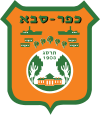Kfar Saba, Israel
Kfar Sava
|
|||
|---|---|---|---|
| Hebrew transcription(s) | |||
| • ISO 259 | Kfar Sava | ||
| • Translit. | Kfar Sava | ||
 |
|||
|
|||
| Coordinates: 32°10′17″N 34°54′30″E / 32.17139°N 34.90833°ECoordinates: 32°10′17″N 34°54′30″E / 32.17139°N 34.90833°E | |||
| Country |
|
||
| District | Central | ||
| Founded | 1903 | ||
| Government | |||
| • Type | City (from 1962) | ||
| • Mayor | Yehuda Ben-Hamo | ||
| Area | |||
| • Total | 14,169 dunams (14.169 km2 or 5.471 sq mi) | ||
| Population (2015) | |||
| • Total | 96,922 | ||
| Website | www.kfar-saba.muni.il (Hebrew) | ||
Kfar Saba (Hebrew: כְּפַר סָבָא), officially Kefar Sava, is a city in the Sharon region, of the Central District of Israel. In 2015 it had a population of 96,922.
The origins of the name are not known - in Hebrew it means 'grandfather's village'.
Kfar Saba (ancient Capharsaba) was an important settlement during the Second Temple period in ancient Judea, and is mentioned for the first time in the writings of Josephus, in his account of the attempt of Alexander Jannaeus to halt an invasion from the North led by Antiochus (Antiquities, book 13, chapter 15). Kfar Saba appears in the Talmud in connection to corn tithing and the Capharsaba sycamore fig tree. Kfar Saba is mentioned in the Mosaic of Rehob, the oldest known Talmudic text, which dates from around the 3rd century C.E.
Excavations on the site have revealed the remains of a large Roman bathhouse. In the Byzantine periods the ruins of the bathhouse were first converted into fish pools, and later into some form of industrial installation.
Following the Muslim conquest of the Levant in the 7th century, the Arab village of Kafr Saba was established in the area. Around 985 C.E. Al-Muqaddasi described it as a village with a large mosque on the road to Damascus. In 1047, Nasir-i-Khusraw described it as a town on the road to Ramla rich in fig and olive trees.
...
Wikipedia



